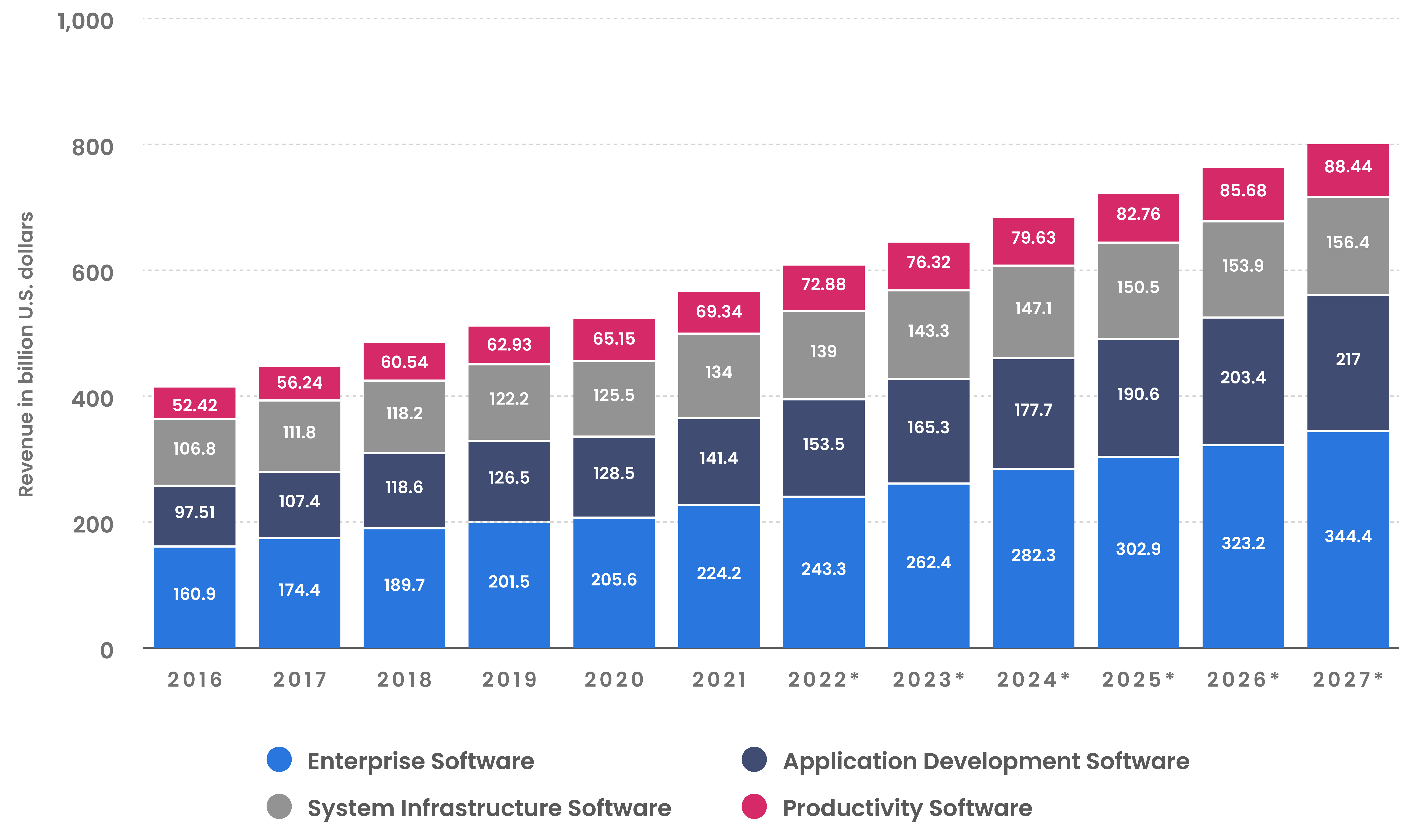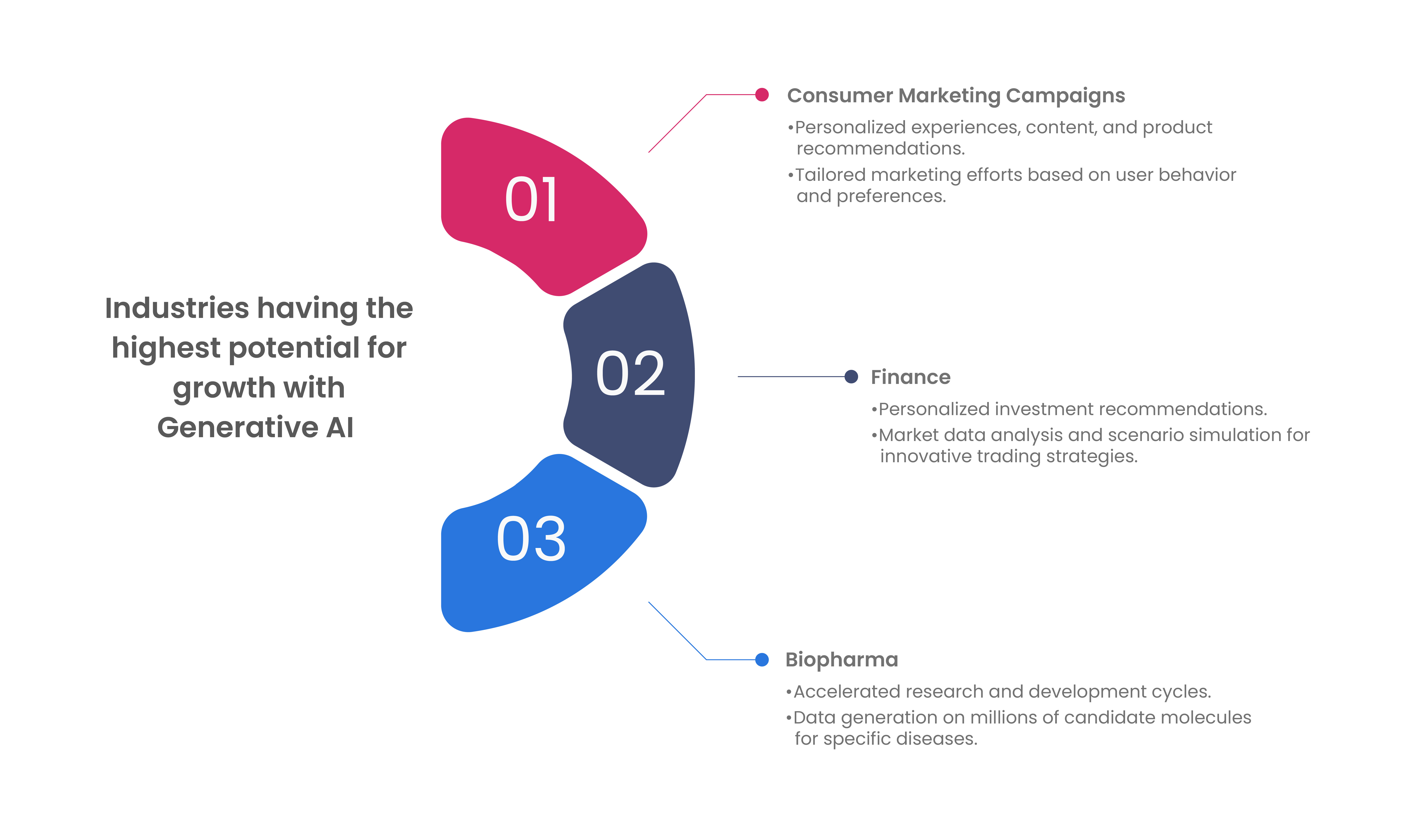
Listen to this blog
The future of business solutions with Generative AI
In the early 2000s, I was building web applications as a developer. The introduction of ASP.NET in 2002 significantly helped the developer community, sparking a wave of desktop-to-web application migrations. Many tools and approaches were developed to address the specific challenges of this transition, which led to the creation of new application architectures.

- Source: Statista
As we stand on the cusp of a new technological era, Generative AI (Gen AI) is set to redefine how businesses operate. Similar to the transformative waves of past industrial revolutions, Generative AI offers capabilities that will fundamentally change the development and utilization of business applications. With the legacy application modernization market projected to reach $32.9 billion by 2025, integrating AI technologies is no longer just a competitive advantage but a necessity. Generative AI services empower businesses to create intelligent, adaptive, and proactive applications, ensuring they stay ahead in an increasingly data-driven world.
The evolution from traditional to AI-powered applications
Traditional applications: Limitations and challenges
Historically, business applications have been rule-based, operating on pre-defined logic that makes them rigid and limited in adaptability. These applications react to user interactions without anticipating future needs, often resulting in a suboptimal user experience. The inability to automatically adapt to dynamic user requirements and changing environments has long been a drawback of such systems.
The AI-powered revolution
In contrast, AI-powered applications leverage vast amounts of data to learn, adapt, and personalize user experiences. These applications are proactive, capable of anticipating user needs and making intelligent recommendations or actions. For instance, a Human Resource Application has coded rules for employee holiday and absence. Each time these rules change, the development team has to go through Software Development Life-Cyle (SDLC). Now imagine, there is an AI-powered application that can read HR policy documents and update the rules for leave requests, without modifying any code.
Over time, AI applications continuously evolve, improving their functionality and user satisfaction through ongoing data interactions. This shift from reactive to proactive systems marks a significant advancement in how business applications operate.
Real-world business applications of Generative AI
Microsoft Dynamics 365 Copilot: A case study
One of the most compelling examples of Generative AI in action is Microsoft’s Copilot within Dynamics 365. This integration showcases multiple functionalities enabled by Generative AI:
- Content generation: Automates the creation of email responses, summaries, and product descriptions, enhancing productivity.
- AI-powered chat: Improves customer service through intelligent chatbots that can efficiently handle various customer inquiries.
- Data retrieval: Streamlines the process of retrieving and summarizing data for marketing and customer insights, enabling more informed decision-making.
- Prioritization: Analyzes several purchase order changes that need review and approval, categorizing them into low, medium and complex impact scenarios. This allows for quick handling of low and medium items and facilitates team collaboration (chat, messages, meetings) to resolve complex issues.
These Generative AI applications demonstrate their transformative potential across different business functions, highlighting their versatility and efficiency.
Building common use cases for Generative AI
Enhancing business operations
Generative AI can significantly enhance various aspects of business operations through:
- Automation: Streamlining repetitive tasks and automating report generation and content creation.
- Personalization: Tailoring user experiences based on individual preferences and behavior, leading to higher user engagement and satisfaction.
- Data-driven decision making: Providing insights and recommendations that support more informed and strategic business decisions.
- Customer service improvement: Utilizing AI-powered assistants to offer superior customer support, resolving queries quickly and effectively.
Developing migration tools and approaches – A systematic approach
We do not need to completely retire, or re-write current application, instead to fully realize the benefits of Generative AI, businesses need a structured approach for integrating AI into legacy applications. This involves:
Step 1. Analyzing existing applications: Understanding the current functionalities and user interactions to identify potential areas for AI integration.
Step 2. Identifying AI integration opportunities: Recommending specific areas where AI can enhance user experience or automate processes.
Step 3. Translating application logic into AI models: Converting existing rules and logic into trainable AI models.
Step 4. Facilitating seamless integration: Providing solutions for integrating AI components into the existing application infrastructure without disrupting operations.

- Source: BCG
Architectural considerations for AI integration
Leveraging various architectural styles
Over the last few decades, various application architectures have evolved and helped in building robust and scalable applications. Each of these architectural styles, such as Client Server, MVC (Model-View-Controller), Event-Driven or Microservices, has certain components that can benefit from Generative AI capabilities, providing faster ROI. For each architecture, developing pattern-based migration strategies and technologies can help bridge existing gaps and accelerate the transition to AI-powered systems.
Conclusion
Generative AI is not just a technological advancement; it's a game-changer for how businesses develop and utilize applications. By embracing Generative AI solutions, businesses can enhance functionality, user experience, and operational efficiency, positioning themselves for success in a rapidly evolving digital landscape. As the legacy application modernization market continues to grow, investing in migration tools and AI integration becomes crucial. With a strategic approach, businesses can unlock new levels of performance and innovation, ensuring they remain at the forefront of technological advancement.

Ameen Ahmad, Head of US West Region
Ameen Ahmad has been in the software industry for over two and a half decades. He has a specialization in partnering with global brands and technology players to harness the power of emerging technologies. Passionate about the intersection of technology and business, Ameen focuses on driving innovation through the strategic implementation of Generative AI and cloud-native platforms.




